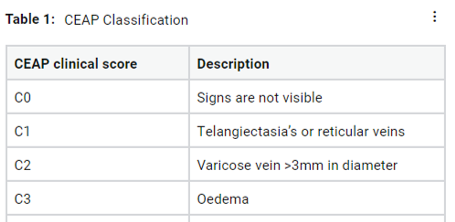Abstract
A varicose vein is a condition which affects a large number of people in Western countries and India especially, the northern areas. For curing this proper disease diagnosis, sufficient care for patient and treatment strategies are required, to control the symptoms and signs of varicose vein, the flavonoid group of drugs have been widely used for many years. Under this group, Daflon is the most potent and efficient drug which can be used. This enhances the bioavailability and absorption from the gastrointestinal area. Improved quality of patient’s life and efficacy makes this drug therapy more potent and significant. Some of the clinical studies have shown its better action for increased venous tone, lymphatic drainage, decreases cosmetic disfigurement, inflammatory responses occur in microcirculation, protection from free radicals and improved quality of life and efficacy. When compared with other available drugs like Polidocanol, Sotradecol, Asclera, Varithena, Sodium tetradecyl sulfate etc. clinical benefits of Daflon is more. This drug is useful in the early stage and can be used in severe condition along with sclerotherapy, compression treatment and surgery. Increased patient’s quality of life and increased efficacy were observed in Daflon treated group. Thus it is efficacious as a standard therapy alone and also in combination with other conservative treatment.
Full text article
References
Agarwal, V., Agarwal, S., Singh, A., Nathwani, P., Goyal, P., Goel, S. 2016. Prevalence and risk factors of varicose veins, skin trophic changes, and venous symptoms among northern Indian population. International Journal of Research in Medical Sciences, 4(5):1678–1682.
Antignani, P. L. 2017. Medical Treatment of Chronic Venous Disease. SM J Pharmac Ther, 3(1):1015.
Feliciano, B. A., Dalsing, M. C. 2011. Varicose Vein: Current Management. Advances in Surgery, 45(1):45–62.
Goldman, M. P., Fronek, A. 1989. Anatomy and Pathophysiology of Varicose Veins. The Journal of Dermatologic Surgery and Oncology, 15(2):138– 146.
Heller, J. A., Evans, N. S. 2015. Varicose veins. Vascular Medicine, 20(1):88–90.
Jacob, P. 2015. Open surgery for primary varicose veins. Chronic Venous Disorders of the Lower Limbs: A Surgical Approach, pages 55–67.
Jill, M. M., Allen, H., Cassio, L. 2012. Vascular Diseases- Varicose Veins. The Journal of the American Medical Association, 308(24):2638.
Kong, J., Liu, P., Li, J., Fan, X., Wen, J., Zhang, J., et al. 2018. Surgical treatment of recurrent varicose veins in the lower limbs associated with endovascular treatment of iliac vein stenosis. International Journal of Surgery, 50:110–113.
Korthuis, R. J., Gute, D. C. 1997. Postischemic Leukocyte/Endothelial Cell Interactions and Microvascular Barrier Dysfunction in Skeletal Muscle: Cellular Mechanisms and Effect of Daflon® 500 mg. International Journal of Microcirculation, 17(1):11–17.
Mulla, S. A., Pai, S. 2017. Varicose veins: a clinical study. International Surgery Journal, 4(2):529– 533.
Naoum, J. J., Hunter, G. C., Woodside, K. J., Chen, C. 2007. Current Advances in the Pathogenesis of Varicose Veins. Journal of Surgical Research, 141(2):311–316.
Neglén, P., Hollis, K. C., Olivier, J., Raju, S. 2007. Stenting of the venous outflow in chronic venous disease: Long-term stent-related outcome, clinical, and hemodynamic result. Journal of Vascular Surgery, 46(5):979–990.
Rabe, E., Pannier, F. 2012. Clinical, aetiological, anatomical and pathological classification (CEAP): gold standard and limits. Phlebology, 27(1_suppl):114–118.
Ramelet, A. A. 2001. Clinical Benefits of Daflon 500 mg in the Most Severe Stages of Chronic Venous Insufficiency. Angiology, 52(1_suppl):S49–S56.
Rutherford, R. B., Padberg, F. T., Comerota, A. J. 2000. Venous scoring, An adjunct to venous outcome assessment. J Vasc Surg, 31(6):1307–1312.
Santler, B., Goerge, T. 2017. Chronic venous insufficiency - a review of pathophysiology, diagnosis, and treatment. JDDG: Journal der Deutschen Dermatologischen Gesellschaft, 15(5):538–556.
Zhang, S., Melander, S. 2014. Varicose Veins: Diagnosis, Management, and Treatment. The Journal for Nurse Practitioners, 10(6):417–424.
Authors

This work is licensed under a Creative Commons Attribution-NonCommercial-NoDerivatives 4.0 International License.

